Lean and flavorful, Japanese Shorthorn beef is popular with many connoisseurs of good food. It was approved as a native breed of Japan in 1957. But production has plummeted with the liberalization of beef imports in 1991, and today Japanese Shorthorns make up less than one percent of the total beef cattle population in Japan.
A Rare Breed Native to Northern Japan
The principle of livestock breeding is to obtain proteins for human consumption from grassland resources that do not conflict with human food needs. But in contemporary livestock farming in Japan, particularly beef cattle breeding, grains—which are human food—are fed in large amounts. The majority are imported grains and primarily consist of corn.
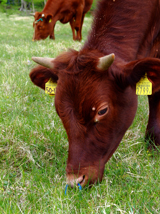
The total number of beef cattle being bred in Japan comes to about 2.80 million, among which, as of 2007, 1.74 million were of beef breeds. Beef breed cattle mainly refer to Wagyu or Japanese beef cattle. There are four major Wagyu breeds: Japanese Black, Japanese Brown, Japanese Shorthorn, and Japanese Polled.
Kobe, Maesawa, Matsuzaka, and Yonezawa, all of which are brand beefs that are highly acclaimed nationwide as well as worldwide, belong to the Japanese Black group. Their most distinguishing feature is the marbled meat, which is so tender that it seems to melt in the mouth. This type of meat can only be produced by efficient feeding of high-calorie grains to the cattle and raising them with limited exercise in cattle stalls. Brand beef are the result of many years of hard work by producers and research institutes. Today a good 96 percent, or 1.67 million, of the beef breed cattle grown in Japan are Japanese Blacks.
The Japanese Shorthorn, by contrast, is a rare breed that accounts for less than 1 percent of all beef cattle in Japan. The roots of Japanese Shorthorn cattle partly lie in the Nanbu cattle that were bred in the former Nanbu domain in northern Japan during the Edo period (1603-1868). Nanbu cattle were utilized as beasts of burden that mainly carried seafood, salt, and iron from the Pacific coast to the inland and rice, sake, and daily supplies from the inland to the coast.
After American Shorthorn cattle were introduced to Iwaizumicho, Iwate Prefecture, in June 1871, they were crossbred with Nanbu cattle. Subsequently, the use of cattle for transporting goods steadily declined with changes in industrial structures and the development of transportation systems, and Nanbu cattle were gradually modified into beef cattle. In 1945 they were registered in Iwate Prefecture as Akage Tohoku-shu (Tohoku Brown), but nine years later the appellation was standardized to Nihon Tankaku-shu (Japanese Shorthorn). The Japanese Shorthorns of today are the product of various further refinements that have been made since the establishment of the Japanese Shorthorn Cattle Registry Association in 1957.
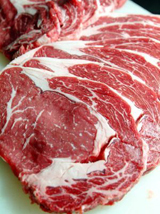
Japanese Shorthorn cattle are resistant to cold, suited to open grazing, and good at rearing their young. Unlike the fatty marbled meat of Japanese Blacks, Japanese Shorthorns produce lean, flavorful red meat. This owes in large part to the genetic traits of Shorthorn cattle and to a grazing system known as natsuyama fuyusato . Feeding of Japanese Shorthorn cattle relies less on grains than Japanese Black cattle and can be conducted in a manner suited to the physiology of the cows. This is thanks to the years of work by local farmers to breed cattle that are well adapted to the harsh climate and social conditions of the northern Tohoku region.
Unfortunately, production of Japanese Shorthorn cattle has been on the wane since the liberalization of beef imports in 1991. Even in Iwate Prefecture, the largest producer, less than 1,000 head are annually shipped for slaughter. But the decline in the production of Japanese Shorthorn beef has an immeasurable impact on the local economy, being deeply connected to the history and life of the region.
Spring and Summer Grazing
As noted above, Japanese Shorthorn cattle are grazed in a system called natsuyama fuyusato . Literally meaning "summer mountain, winter village," this is a system whereby the cattle spend the summers grazing on plentiful grass in vast mountaintop pastures and the winters feeding in stalls as quasi members of the farm household.
In Iwaizumicho, Iwate Prefecture, which is considered to be a center of Japanese Shorthorn beef production, Japanese Shorthorn cattle and their offspring are sent to graze on gently rolling pastures in the Kitakami Mountains around mid-May, when the cherry blossoms have fallen and trees begin to shoot tender new leaves. The pastures, located at altitudes of 800 to 1,000 meters, have areas of between 25 and 30 hectares. Each vast pasture plot accommodates 40 to 50 cows and a single bull, which is referred to as makiushi . Their calves are born here in February and March.
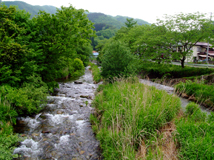
Producers take the cattle up to the mountains by truck and conduct weight and hygiene checks before releasing them. This move is called yamaage , which literally means "to take up to the mountains." The cattle spend the several months until October eating plenty of grass and exercising. The calves grow strong and sound as they feed on their mothers' milk.
The most important part of this pasturing period is mating. Whereas Japanese Black cattle are bred by artificial insemination, more than 90 percent of the Japanese Shorthorns of Iwaizumicho are born by natural mating. The lone makiushi set out to graze with 40 to 50 cows single-handedly takes on this task. These studs are selected for their excellent pedigree, but mating appears to be heavy work even for them, and they lose more than 100 kilograms by the end of the breeding season.
Japanese Blacks, by contrast, are systematically bred year-round almost entirely by artificial insemination. The calves are weaned within 2 to 3 months after birth and are taken to market at around 10 months. There, male calves are put up for auction as beef cattle, while females are auctioned as either beef or breeding cattle. Beef cattle are fattened for roughly 20 months, during which they are generously fed a concentrated diet mainly consisting of hay and corn, before being shipped out to meat markets.
The grade of the shipped beef is determined by yield ratio and meat quality. Naturally, higher grades fetch higher prices. As the degree of marbling defines meat quality, Japanese Black cattle are efficiently fattened by restricting exercise.
Fall and Winter Stall Feeding
The grazing season ends around mid-October, as the leaves set the mountains ablaze with red and yellow hues. By this time, nighttime temperatures can fall below freezing. Japanese Shorthorn calves born in the spring will have grown into fine young cows, having fed on plenty of milk and grass. They are taken down the mountains along with their mothers, now pregnant with the next generation of calves.
As with yamaage , the cattle know that it is time for yamasage , or descent from the mountain. Headed by their leader, they gather of their own accord to be taken back down to the village.
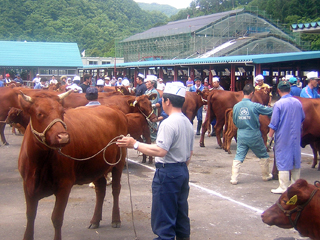
After the cattle have returned to the village, it is time to sell the calves. Calf markets were once held in various locales as festive village-wide events, called oseri , but nowadays they are only held at the Iwate Central Livestock Market. Here, the breeders sell their calves to feedlots, where they will be fattened for meat.
The mother cows spend the winter in stalls adjoined to the farm household. They mainly feed on rice straw produced in the village fields while the cattle were grazing in the mountains, dent corn silage (fodder made by lactic acid fermentation of feed corn, including the stems), and sun-dried grass. The majority of naturally conceived calves of Japanese Shorthorns are born between February and March, while temperatures drop below minus 10 degrees Celsius and freeze the fallen snow into ice. In the spring, the cows are once again set to graze in the mountains with their newborn.
Japanese Shorthorn calves that have been sold off to feedlots spend the next 14 to 18 months being fattened to produce delicious beef, or "finished." During the fattening period, they are fed locally supplied hay, silage, and rice straw, as well as concentrated fodder made from corn and other grains, to yield healthy red meat. The concentrated fodder fed in Iwate Prefecture is made from nongenetically modified ingredients without adding hormones. Finally, the cattle are shipped to be processed and sold as beef at the age of 22 to 25 months.
Healthy Japanese Shorthorn beef with its full-bodied flavor is produced in this manner.
Birthplace of the Japanese Shorthorn
Japanese Shorthorn cattle have their ancestry in the Nanbu cattle that were bred in the former Nanbu domain, which lay across what are now Iwate, Aomori, and Akita prefectures. There is no clear evidence as to where the Nanbu cattle came from—suggested places of origin include Russia and Mongolia—but as many as 15,000 head of cattle were kept during the Edo period. The center of Nanbu cattle production was Hei County in today's northeastern Iwate Prefecture. Particularly famed were the Kamatsuta cattle that were bred in a village of the same name nestled in the Kitakami Mountains, now known as the Kamatsuta district of Iwaizumicho.
Traditionally interested in breed improvement, the producers of Kamatsuta actively brought in foreign-bred cattle and cattle of foreign strains for hybridization. While some regions began crossbreeding Japanese Shorthorns with Japanese Blacks following the liberalization of beef imports, Kamatsuta producers remained faithful to the Japanese Shorthorns that their predecessors had worked so hard to refine. The same spirit lives on among young producers in their twenties and thirties.
Model District for Ecologically Harmonious Agriculture
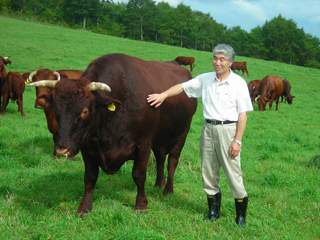
The Akka district (formerly Akka Village), also in Iwaizumicho but farther north, is another area that has produced Japanese Shorthorn cattle from the Meiji era (1868-1912). Since the early days, cattle have grazed in the wooded meadows skirting the 1,239-meter-high Akka Forest in the district's northern margin, giving rise to an idyllic grassy landscape known as kanukadaira .
The century-old tradition of woodland grazing in the kanukadaira was halted in 1992. The number of Japanese Shorthorn cattle being bred in Akka steeply declined with the liberalization of beef imports, and it became impossible to continue the natural but inefficient method of woodland grazing. As a result, shrubs and bamboo grass came to grow over the grass, blocking the sunlight needed for fallen beechnuts to germinate.
Then, in 2000, residents of Akka and the neighboring town of Kuzumakimachi launched the Akka Forest Club. They revived kanukadaira grazing in the hopes of restoring the beautiful landscape of Akka Forest and passing down the mountainous lifestyle of coexisting with Japanese Shorthorns to future generations. The club came up with the "woodland grazing supporter system" to let the wider public know about the undertaking and help sustain the economically difficult venture. Despite initial concerns about recruiting enough supporters, there are now over 160 supporters from all over Japan. In 2008, 15 Japanese Shorthorns were set out to graze in a 17-hectare stretch of kanukadaira .
Cows are grazing animals by nature. Japanese Shorthorn cattle live on a diet that mainly consists of grass and is very low on grains, which are essentially intended for human consumption. With global food shortages predicted in the near future, Japanese Shorthorns deserve to be cherished as a valuable meat source and a local heritage.
Photos: Hiroaki Horiguchi
